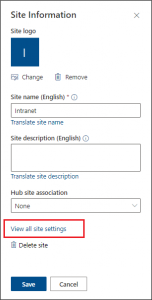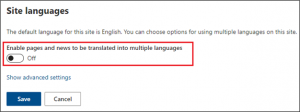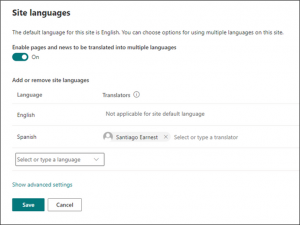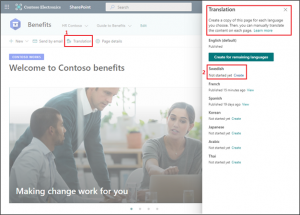Multilingual Publishing for SharePoint Pages
Many organizations have remote workers who live around the world. These multi-national organizations need an intranet where they can publish content in multiple languages for employees in each location.
Microsoft SharePoint released a new feature for SharePoint pages that includes multilingual publishing. This feature enables you to create and translate pages, set translator roles, and get email alerts when pages are ready to be translated, updated, and published. It is not rolled out worldwide.
It works for the site collection which is built on a communication template only. Once the site owner creates the default language, they can enable the multilingual publishing feature and choose additional languages to support it.
Let us see how multilingual publishing for modern SharePoint Pages works.
1.Go to site collection and from the top right click gear icon and select ‘Site information’.


2. From the Site information dialog click ‘View all site settings
3. From the site settings page, click ‘Language settings’ under ‘Site Administrator’

4. Turn on ‘Enable pages and news to be translated into multiple languages’

5. Under ‘Add or remove site languages’ select the other required languages and their respective translators

6. Once the page authors create the original page in the default language, translators can manually translate the writing into other languages

7. Published translation pages automatically show up in the users’ language.
8. Users automatically see translated pages and news in their preferred language. If not the page is not available in their preferred language, , they can use the dropdown menu in the top right corner of the page to see other available languages for the page.

Notes:
a. Page translation features are available on communication sites only.
b. Pages are not translated automatically. Each page created in your default language can have a corresponding page in a chosen target language. After you translate the page, it will automatically be displayed to users who prefer that language.
c. Changes to the original, source page or to other translation pages are not automatically synced with all translation pages. Each translation page must be updated manually.
d. The language displayed to a user will depend on their personal language and region settings.
e. The multilingual features described in this article are not available on subsites.
Final thoughts
Publishing SharePoint pages in multiple languages is useful for organizations with employees spread out around the globe. If you want to use this feature to better disseminate communications to your employees, let us know how we can help you. Contact us today for help with multilingual publishing on your SharePoint pages.






